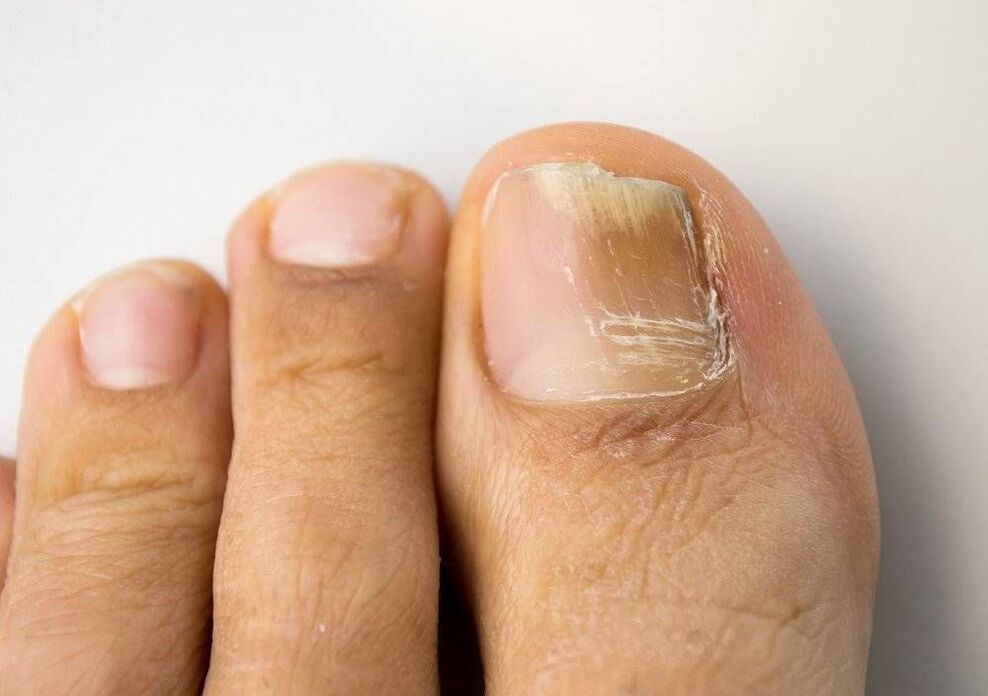
fungus on big toe
Symptoms of big toe fungus
- Itching and burning sensation on the skin around the nails;
- Swelling and redness of the skin;
- Cracks and irritation of the skin;
- Yellow or white spots on the skin;
- foul smell;
- Traces of peeling skin.
Big Toe Fungus Treatment
Folk ways to treat big toe fungus
Prevent big toe fungus
- Maintain good foot hygiene.Wash your feet regularly with soap, paying special attention between the toes. After washing, dry your feet thoroughly.
- Avoid high humidity.Fungus loves moist conditions, so try to keep your feet dry. Always dry your feet after swimming or walking in the rain.
- Wear the correct size of shoes.Shoes that are too tight can damage nails and create conditions for fungus to grow. Choose shoes based on the individual characteristics of your feet.
- Avoid going to public places.Wear special shoes or sandals to protect your feet in swimming pools, saunas and other places where humidity is high and surfaces may be contaminated by pathogenic fungi.
- Do not use other people's hygiene products.Do not use someone else's towels, socks, shoes or personal hygiene products as they may be contaminated with fungus.
- At the first sign, consult your doctor.If you notice changes in your nails or experience itching or burning, you should get checked out by a specialist. Consulting your doctor early will allow you to start treatment on time and prevent the spread of the fungus.
How to Prevent Fungal Infection of the Big Toe
- Follow the rules of foot hygiene: Wash and dry your feet regularly, paying special attention to the folds between the toes.
- Avoid walking barefoot in public places, especially swimming pools, showers and changing rooms. Instead, wear special sandals or shoes.
- Use only your own shoes and socks and do not share with others.
- Avoid using shared personal care items such as towels or nail clippers.
- If you already have onychomycosis, consult your doctor immediately for diagnosis and treatment.
Foot Hygiene to Prevent Fungus
- Keep your legs and feet hygienic. Wash your feet regularly with soap, paying special attention to your toes and the spaces between them.
- Dry your feet after each wash, especially between the toes. Use a separate towel to wipe your feet.
- Avoid wearing shoes barefoot in public areas such as swimming pools, saunas and locker rooms.
- Avoid using other people's shoes, socks and towels.
- Pay special attention to nail hygiene. Cut and file your nails regularly to avoid injury. Do not use other people's cosmetics.
- Always wear rubber slippers or flip-flops when going to the swimming pool or public showers.
Characteristics of shoes with big toe fungal infection
Choose the right shoes
Change socks and shoes regularly
Continue to use antifungal medications
Big toe fungus symptoms in children
Fungus appears on children's big toes
Big toe fungus symptoms in children
- Nail color changes (white, yellow, or brown spots)
- Changes in nail shape or structure (thickness, brittleness, cracking)
- Nails peeling off the nail plate
- Pain or burning sensation at the site of fungal infection
Treatment of big toe fungus during pregnancy
Big toe fungus symptoms in pregnant women
Treatment of big toe fungus in pregnant women
- Use disinfectant. Some women may prefer to use a solution to treat the affected nail bed.
- Use cosmetic files. A cosmetic file can help remove the affected part of the nail and speed up its regrowth.
- Observe hygiene measures. Regularly changing socks and shoes, as well as using special shoe treatment products, can help prevent fungal reinfection.
Spread of fungus to other nail plates
Signs of big toe fungus allergy
Signs and symptoms of big toe fungal allergy:
- Redness and itching of the skin around the affected nail. This can be one of the first symptoms of an allergic reaction.
- Swelling and discomfort in the big toe area. If you are allergic to fungi, you may experience swelling and redness of the skin.
- Rashes and blisters develop. An allergic reaction may occur with a rash and blisters on the skin around the affected nail.
- The skin is scaly and flaky. If your big toe is allergic to fungus, your skin may become dry, scaly, and flaky.
- Avoid wearing shoes that cause discomfort or pressure on the affected nail.
- Use personal hygiene products such as nail files to avoid the spread of fungal microorganisms between nails.
- Research information about the drug's manufacturer to ensure its quality.
Big toe fungal allergy treatment
Complications caused by big toe fungus
Problems Caused by Big Toe Fungus
- Fungal infection on deck;
- occurrence of antifungal drug reactions;
- Medication is not effective enough;
- Nail problems and their complete loss.




























